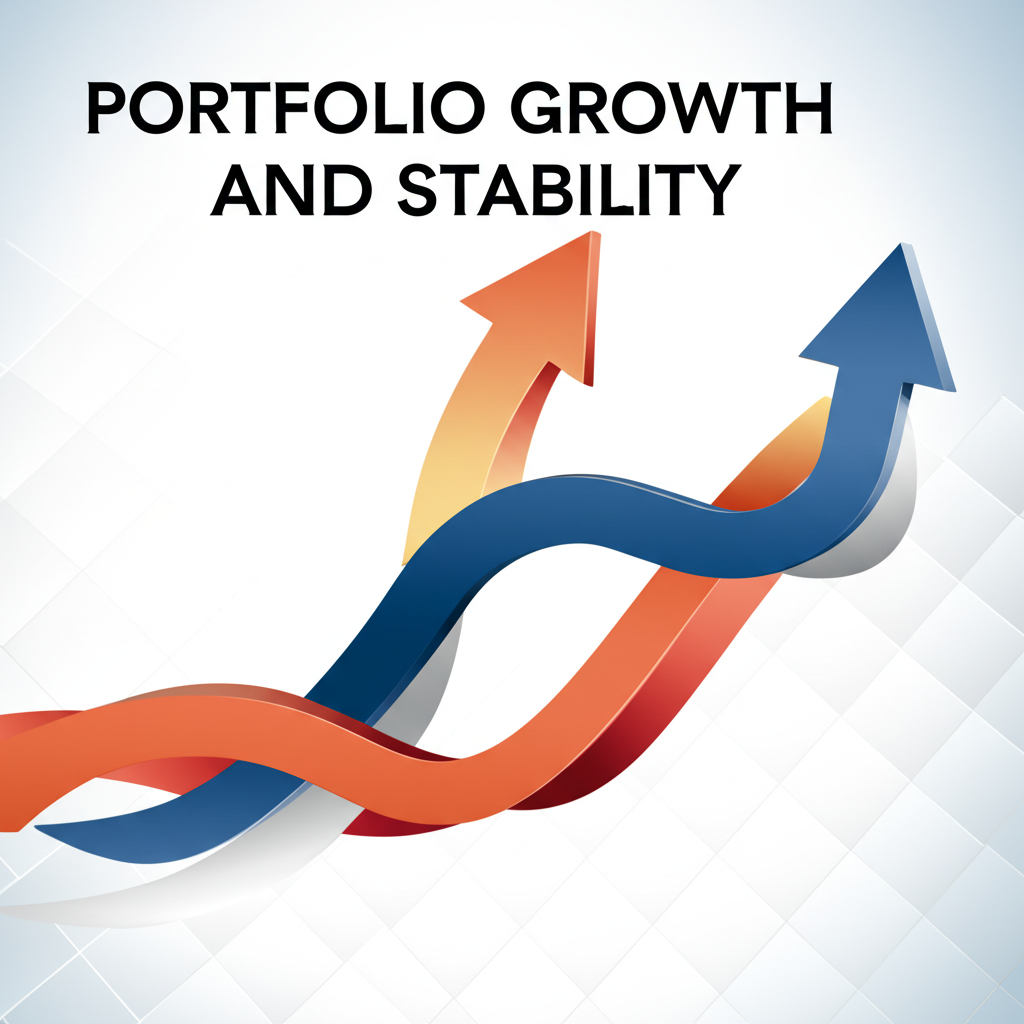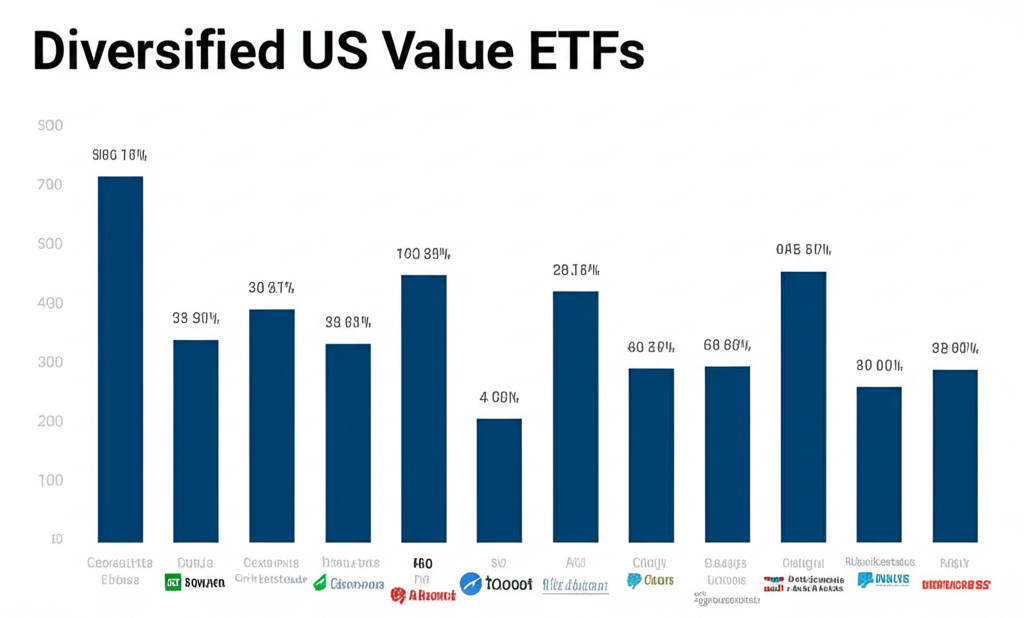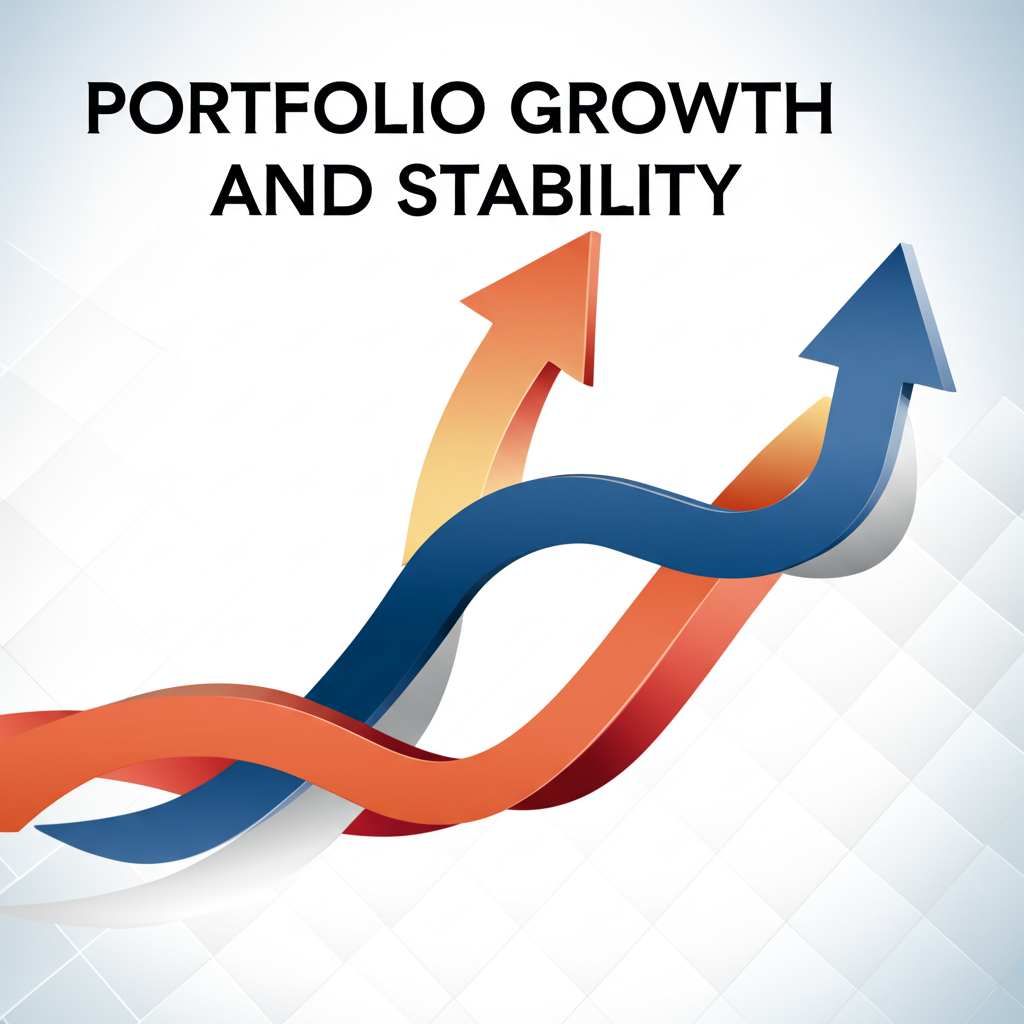Introduction to Value ETFs for United States Investors in 2025
In today’s ever-shifting U.S. investment scene, value exchange-traded funds (ETFs) stand out as a smart choice for those chasing steady long-term growth and a buffer against ups and downs. Heading into 2025, experts point to economic trends and market patterns that could spotlight value strategies, helping shield portfolios from turbulence while opening doors to solid gains. This guide targets everyday U.S. investors-whether you’re dipping your toes in or fine-tuning a well-worn approach. We’ll break down what value ETFs are all about, weigh their upsides and pitfalls, outline how to pick the right ones, and walk through adding them to your holdings with tips geared toward today’s conditions.

Understanding Value Investing: Growth vs. Value in the US Market
Value investing boils down to snapping up assets priced below their true potential. It means spotting firms whose shares trade at a discount to their core strengths, usually thanks to short-lived market glitches or sour moods. Icons like Benjamin Graham and Warren Buffett championed this method, stressing thorough digging and a patient outlook. On the flip side, growth investing zeros in on outfits poised for rapid expansion, where folks shell out extra for tomorrow’s promise, leading to steeper price tags.

Over the years, value and growth plays have traded the lead in the U.S. arena. Booms in growth, fueled by breakthroughs and big hopes, tend to give way to value’s comeback, especially amid economic pivots or climbing rates. Looking at 2025, with possible tweaks to Fed policy and a spotlight on bedrock businesses, watchers think value could reclaim ground, bringing toughness and steadiness that growth might lack. Grasping these swings helps American investors set up their mixes for success.
What Are Value ETFs and How Do They Work for United States Investors?
Value ETFs pool together a spread of stocks from companies flagged as bargains using key financial yardsticks. Rather than poring over single stocks, which demands deep dives per pick, these funds deliver built-in variety across a slew of value picks. They usually mirror benchmarks like the Russell 1000 Value or S&P 500 Value, built around traits such as modest price-to-earnings (P/E) multiples, slim price-to-book (P/B) ratios, and generous dividend payouts.
For folks investing stateside, value ETFs make it straightforward and wallet-friendly to tap into this market slice. They mix mutual fund-style spreading of risk with stock-like ease of trading, letting you jump in or out during market hours on big U.S. exchanges. This setup cuts the dangers of betting on lone winners while aiming for the edge that cheap assets can deliver when prices catch up.
Key Benefits of Investing in Value ETFs in the United States for 2025
Adding value ETFs to your U.S. lineup can bring real perks, particularly as 2025 unfolds:
- Shot at Strong Long-Term Wins: History shows value tactics shining in stretches when the spotlight shifts from hot growth names. Though no guarantees, grabbing underpriced gems often pays off big once the market wakes up to their worth.
- Built-In Variety: By design, ETFs spread bets across holdings. Value versions take it further, mixing sectors and firms that fit the bill, softening blows from any one flop.
- Steady Income from Payouts: Value plays are often mature operations churning reliable cash and sharing it via dividends. These ETFs tend to yield more than growth peers, giving a reliable stream to compound or draw on.
- Easier Way to Get Started: If you’re not into micromanaging, value ETFs handle the heavy lifting. Skip the solo scrutiny of financials; one trade gets you wide access.
- Fitting the 2025 Economic Picture: With rates in flux and growth cooling, firms boasting solid roots and fair prices could draw crowds. Value ETFs are primed to ride these waves, holding firm amid fog.
Identifying and Avoiding “Value Traps” in the US Market
Value sounds great, but watch for pitfalls like “value traps”-stocks that look cheap on paper yet keep sinking or flatlining due to crumbling basics. Think fading giants, tech dinosaurs, or debt-laden drags facing wipeout.
Red flags often pop up as:
- Sliding sales or profits over time.
- Mountainous debts choking progress or risking bust.
- Stale setups or wares losing ground to rivals.
- No real edge in their field.
- Choppy or halted dividend streams.
Even in ETFs, peek under the hood: Does the index weed out duds? Diversification helps, but a tilt toward troubled areas can drag. Seek funds blending value with quality-think enduring operations and clean books, not just low tags. For U.S. folks, this keeps your edge sharp.
How to Choose the Right Value ETFs for Your US Portfolio in 2025
Picking the perfect value ETF means sizing up a few angles to match your setup.
Essential Metrics for US Value ETFs:
- Price-to-Earnings (P/E) Ratio: Lower numbers signal bargains, meaning less cash per earnings buck.
- Price-to-Book (P/B) Ratio: This gauges market price against assets’ book worth; slim ratios hint at steals, especially asset-rich spots.
- Dividend Yield: Bumper yields point to steady earners giving back to owners, a value staple.
- Expense Ratios: The yearly cut from providers-aim under 0.20% to keep more gains yours.
- Tracking Error: How tight the ETF hugs its benchmark; minimal slips mean smooth sailing.
Diversification and Sector Exposure:
Dig past the stats to the guts: Holdings might lean heavy into finance, manufacturing, or oil. That’s fine if those areas boom, but it risks bunching up. Match the mix to your big-picture spread and hunches on U.S. slices like tech or consumer goods.
Fund Provider Reputation:
Big names like Vanguard, Fidelity, iShares (from BlackRock), Schwab, and WisdomTree rule the U.S. ETF space. They dish out value options with tight costs and easy flow, backed by solid track records and tools that ease worries.
Liquidity and Trading Volume:
For hassle-free moves on U.S. floors, grab funds with brisk daily action. Solid volume keeps trades quick and prices true, dodging wide gaps.
Top Value ETFs for United States Investors to Consider in 2025
If you’re eyeing value ETFs as a U.S. investor, check these standouts. Always vet them yourself using the guidelines here.
- Vanguard Value ETF (VTV): A heavyweight favorite, VTV follows the CRSP US Large Cap Value Index for wide reach into big U.S. value names across finance, health, and making things, all at a rock-bottom 0.04% expense ratio.
- iShares S&P 500 Value ETF (IVE): Tracking a value slice of the S&P 500, IVE taps iconic U.S. giants, blending large-scale value with balance.
- iShares Russell 2000 Value ETF (IWN): Aiming smaller, IWN hits the value side of the Russell 2000, promising more upside but with extra swings.
- Invesco S&P 500 High Dividend Low Volatility ETF (SPHD): Not pure value, but SPHD picks S&P 500 stocks for fat dividends and calm rides-many echo value vibes for income and defense.
- Fidelity Value Factor ETF (FVAL): FVAL hunts U.S. firms with sweet valuations via Fidelity’s in-house smarts, adding an active twist to index plays.
Integrating Value ETFs into Your Overall US Investment Strategy for 2025
Weaving value ETFs into your 2025 plan calls for strategy:
- Portfolio Allocation Strategies: Figure your slice for value based on gut for risk, timeline, and market read. Some anchor with it; others sprinkle to offset growth bets.
- Combining Value with Growth or Other Asset Classes: Balance shines in mixes-value’s calm and cash flow tempers growth’s zip (and jitters), plus bonds or property.
- Rebalancing Considerations: Check in often to keep weights right. If value surges, trim to buy laggards and stick to plan.
- Using Value ETFs for Core Holdings vs. Satellite Positions: Broad ones suit cores for steady market touch; niche like small-value or dividend-heavy work as add-ons for targeted boosts.
- Aligning with Long-Term Financial Goals in the United States: Tie it to aims like nest eggs, home funds, or keeping wealth-value fits horizons where patience lets deals bloom.
How to Invest in Value ETFs in the United States: Choosing a Broker
To dive into value ETFs in the U.S., start with a brokerage setup. Steps usually go like:
- Choosing a Broker: Pick one that fits (more below).
- Opening an Account: Fill forms with basics, money info, and tax ID.
- Funding Your Account: Wire cash via ACH, transfer, or mail check.
- Placing Orders: Search by ticker, then buy away.
Fees matter: Many skip commissions on ETFs, but scout for upkeep, idle, or special charges. Stick to SEC-watched, FINRA-joined, SIPC-backed outfits for safety.
Best Brokers for Value ETF Investing in the United States (2025)
For U.S. value ETF action, weigh ease, costs, and help.
- Moneta Markets: A prime pick for U.S. traders wanting a sturdy setup with fair rates and broad picks like ETFs. It boasts a clean interface, top-notch support, and sharp analysis tools for newbies and pros alike. Holding an FCA license, its focus on education and safe trades makes it ideal for steering your value ETF bets in 2025.
- IG: Famous for deep access and pro tools, IG delivers a full suite for U.S. folks chasing ETF variety. Solid learning aids and tight pricing on listed ETFs appeal to day traders and holders.
- OANDA: With a simple dash and clear costs, OANDA suits U.S. investors eyeing ETFs. Strong service and U.S. regs create a trusty spot, especially for straightforward plays.
- FOREX.com: Forex roots aside, it opens doors to assets like ETFs via a powerful platform. Quick fills and deep charts help active U.S. types digging research.
Risks Associated with Value ETFs for US Investors
Value ETFs pack perks but come with caveats:
- Market Risk: Stocks mean broad drops can hit even smart value picks.
- Underperformance Relative to Growth in Certain Cycles: Value may lag growth for stretches; stick it out with a long view.
- “Value Trap” Risk: Spread or not, some holdings might be true lemons-vet the picks process.
- Sector Concentration Risk: Tilts to value haunts like banks or fuel could sting if those stumble.
- Liquidity Risk for Less Popular ETFs: Big ones flow easy; oddballs might widen spreads, complicating trades.
Tax Implications of Value ETF Investing in the United States
U.S. investors need to grasp taxes on value ETFs.
- Capital Gains: Profits on sales trigger taxes-short holds (under a year) at income rates; longer at 0-20% based on earnings.
- Qualified Dividends vs. Ordinary Dividends: Value payouts often qualify for lower rates; others hit as income. Providers clarify.
- Wash Sale Rule: Sell at loss, buy similar within 30 days? No deduction-key for loss grabs.
- Tax-Loss Harvesting Strategies: Dump losers to cut gains or income (capped); value fits, but dodge washes.
- Importance of Consulting a US Tax Advisor: Rules twist; get pro input for your setup. Check IRS on gains via their site.
Conclusion: Your 2025 Outlook for Value ETFs in the United States
Value ETFs pave a reliable road for U.S. investors building smart, spread-out plans with upside in 2025. Mastering value basics, ETF nuts and bolts, plus pros and cons equips you for sharp calls. Vet choices closely-costs, spreads, holding quality. Slot them wisely into your strategy, mind taxes, and pick a steady broker like Moneta Markets to craft a tough, expanding mix. 2025 could favor value’s grit; gear up to grab it.
Frequently Asked Questions (FAQ) about Value ETFs for United States Investors
Are value ETFs a good investment for United States investors in 2025?
Many financial experts believe that Value ETFs could be a strong investment for United States investors in 2025, especially given potential shifts in economic conditions and market cycles. Value stocks often perform well during periods of rising interest rates or economic uncertainty, offering stability and potential for long-term growth. However, like any investment, they carry risks, and individual suitability depends on your financial goals and risk tolerance.
What is the best ETF for value stocks in the US market?
There isn’t a single “best” ETF, as the ideal choice depends on your specific investment goals. Popular and highly-rated Value ETFs for the US market include the Vanguard Value ETF (VTV) and the iShares S&P 500 Value ETF (IVE), known for their broad diversification and low expense ratios. For those interested in smaller companies, the iShares Russell 2000 Value ETF (IWN) is a strong contender. Always compare expense ratios, holdings, and historical performance before investing.
How do I choose the right value ETF for my United States portfolio?
To choose the right Value ETF for your US portfolio, consider several factors: look at the ETF’s expense ratio (lower is generally better), its underlying index and sector exposure, and its historical performance relative to that index (tracking error). Assess the fund provider’s reputation (e.g., Vanguard, Fidelity, iShares), and ensure the ETF has sufficient liquidity for easy trading. Finally, ensure it aligns with your overall investment strategy and risk profile.
What is the 3:5-10 rule for ETF investing in the United States?
The “3:5-10 rule” for ETF investing is a guideline suggesting investors aim for: 3% in expense ratios (total portfolio, not per ETF), hold at least 5 different ETFs for diversification, and invest for a minimum of 10 years to allow for market cycles to play out. While a useful general guideline, these numbers can vary based on individual circumstances and specific investment strategies. Always consult with a financial advisor for personalized advice.
What are some popular Vanguard Value ETFs for US investors?
Vanguard is known for its low-cost, broad-market ETFs. For US investors interested in value, the Vanguard Value ETF (VTV) is arguably the most popular, offering exposure to large-cap US value stocks. Another option is the Vanguard Mid-Cap Value ETF (VOE) for those looking to include mid-sized value companies in their portfolio.
How do Fidelity Value ETFs compare to other providers in the United States?
Fidelity offers a competitive range of ETFs, including value-focused funds like the Fidelity Value Factor ETF (FVAL). They often feature competitive expense ratios and can be particularly attractive to existing Fidelity brokerage account holders due to seamless integration. While similar to Vanguard or iShares in offering broad market exposure, Fidelity may also provide actively managed or factor-based value ETFs that use proprietary screening methodologies, offering a slightly different approach to index-tracking funds.
Are there any best value ETFs with dividends for United States investors?
Many Value ETFs inherently focus on companies that pay dividends, making them suitable for income-seeking US investors. ETFs like the Vanguard High Dividend Yield ETF (VYM) or the iShares Select Dividend ETF (DVY) are popular choices that emphasize dividend-paying stocks, many of which align with value characteristics. When evaluating, look at the historical dividend yield and the consistency of dividend payments, in addition to the ETF’s overall value focus.
What does Morningstar recommend for the best Value ETF in 2025?
Morningstar provides independent research and ratings for ETFs, often highlighting funds with strong management, low costs, and solid long-term prospects. While their specific “best” recommendations can change, they typically favor ETFs like VTV or IVE for their broad market exposure and efficient tracking. You can usually find their latest ratings and analyst reports by visiting the Morningstar website and searching for specific Value ETF tickers. Using a robust brokerage platform like Moneta Markets can also provide access to fundamental research and ratings from various providers, helping you make informed decisions about Morningstar-recommended ETFs.
Can I invest in Value ETFs with Moneta Markets in the United States?
Yes, Moneta Markets is designed to support a wide range of investment products, including Value ETFs, for United States investors. Its platform offers an intuitive user interface that simplifies the process of finding, analyzing, and purchasing ETFs. With competitive pricing, comprehensive analytical tools, and a commitment to client education, Moneta Markets provides an excellent environment for managing your Value ETF portfolio effectively in 2025, whether you are a beginner or an experienced investor.



No responses yet